Emily the Cow Ran Away From the Slaughterhouse And Became a Star
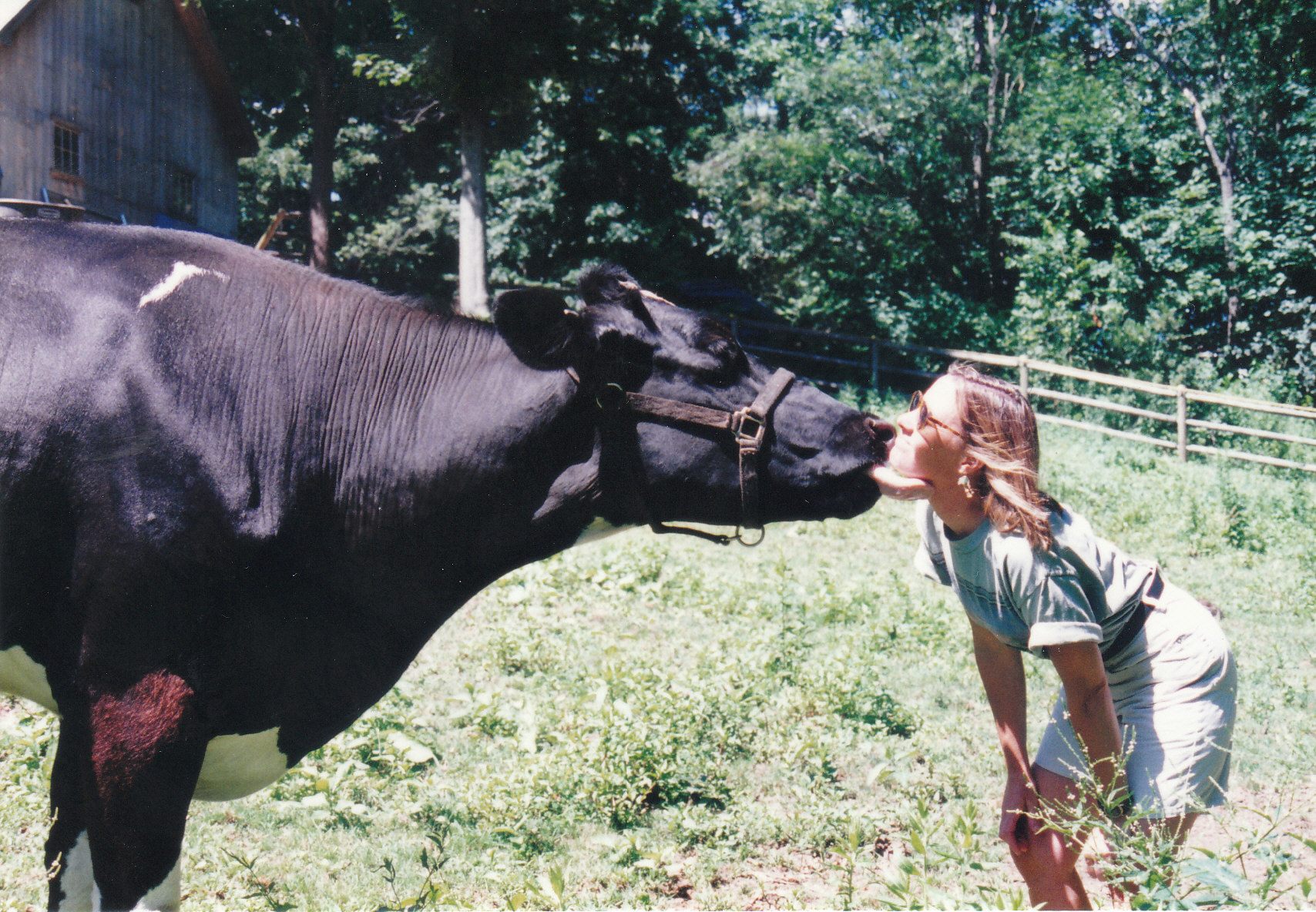 Emily the Cow and Meg Randa show their appreciation for each other. (Photos: Meg Randa/Middlesex News)
Emily the Cow and Meg Randa show their appreciation for each other. (Photos: Meg Randa/Middlesex News)
For Emily the Cow, November 14, 1995 probably started off like any normal day. She would have eaten her breakfast, let out some quiet moos, maybe mulled about with the other cows. By the time she was loaded onto a trailer with others from her herd and driven to nearby Arena Slaughterhouse, in Hopkinton, Massachusetts, she might have guessed things were a little off. By noon, when she was next in line for the kill floor, she knew something was gravely wrong.
That’s when the workers decided to break for lunch—and when this brave bovine decided to take her fate into her own hooves. Belying her 1600-pound bulk, she leapt over the five-foot gate that was holding her in the slaughter line and bolted for freedom.
A group of surprised slaughterhouse workers dropped their sandwiches and chased her, but to no avail. “This is one of the quickest cows I have ever seen,” one employee told a reporter. “I thought she was a reindeer in a cow costume.” Before they fully understood what was happening, the Holstein Houdini was on the loose. The slaughterhouse had lost about $500 in hamburger meat, and the cow had gained a second chance.
With her giant leap, the cow had unknowingly started a journey that would bring together countless people—not just over county lines, but across faiths, cultures, and continents.
 Emily the Cow struts her stuff. (Photo: Meg Randa/Middlesex News)
Emily the Cow struts her stuff. (Photo: Meg Randa/Middlesex News)
But first, Emily had to survive a Massachusetts winter—no mean feat for any creature, let alone one accustomed to the sedate, cloistered rhythms of farm life. For weeks, the cow on the lam avoided emissaries from the slaughterhouse, along with the police—who, after enough failed corral attempts, had been ordered to shoot her on sight.
She even managed to find the 40 pounds of food a day necessary to keep a creature of her size warm during the snowy nights, living off of hay put out by concerned residents and crops from Elmwood Farm—which normally grew food for needy people, but decided not to discriminate based on species. According to several eyewitnesses, she took foraging lessons from some local deer.
Middlesex County is a pretty sleepy place. A cow behind a fence wouldn’t garner much more than a lazy nod of recognition, but one on the loose was exciting enough to make front-page news. Soon, the stories and sightings started piling up. She surprised one family putting up Christmas decorations. She ghosted in and out of people’s backyards, leaving only hoofprints and clouds of steamy breath. She even nosed around the starting line of the Boston marathon, as though plotting, come spring, to put her newfound sprinting skills to good use.
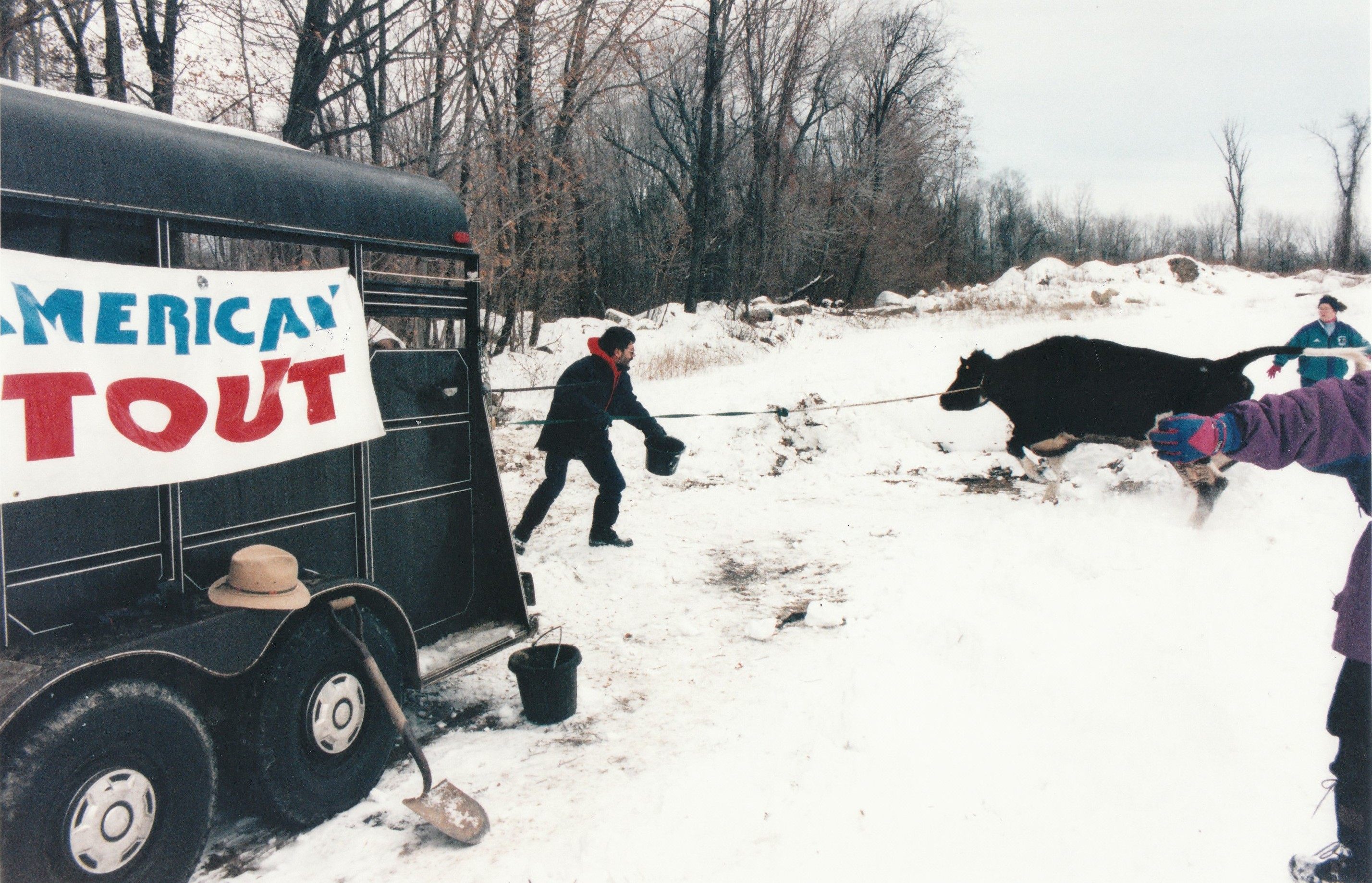
Emily is coaxed onto the trailer. (Photo: Meg Randa/Middlesex News)
To one local family, the fugitive cow was more than a curiosity. Meg Randa first heard about the escape while browsing the local paper during her daughter’s dance class. She and the rest of her family had recently become vegetarians, and something about the story resonated with Randa immediately. “I grabbed [my daughter] and ran out of the studio,” she recalled in a phone interview.
“I went home and showed [my husband] Lewis the article, and I said, ‘We have to do something. We have to save this cow.’”
The Randas didn’t know much about cows, but they did know a lot about banding together for a cause—for nearly a decade, their family had run the Peace Abbey, a foundation in the town of Sherborn dedicated to interfaith peace movements, human rights, and advocacy. The cow’s rescue quickly became a family project (“I became obsessed, completely,” Meg Randa says). The Randas visited the slaughterhouse, and convinced the owners to sell the cow to them for one dollar. “They just wanted to be done with it,” Meg remembers. The Randas also learned her name—Emily.
“As soon as she had a name… she had a face and a personality, and people were really rallying behind her,” Meg says. Whole towns in Middlesex County started coming out to search for Emily, whose chances of survival grew slimmer as the winter progressed. They brought dogs, lassos, news photographers, and other tools that, in retrospect, would be more likely to chase away a fugitive than bring her home. “I finally one day decided to just go by myself,” Meg says. She brought hay and warm water, and walked quietly. Not long after, she was nose-to-nose with Emily.
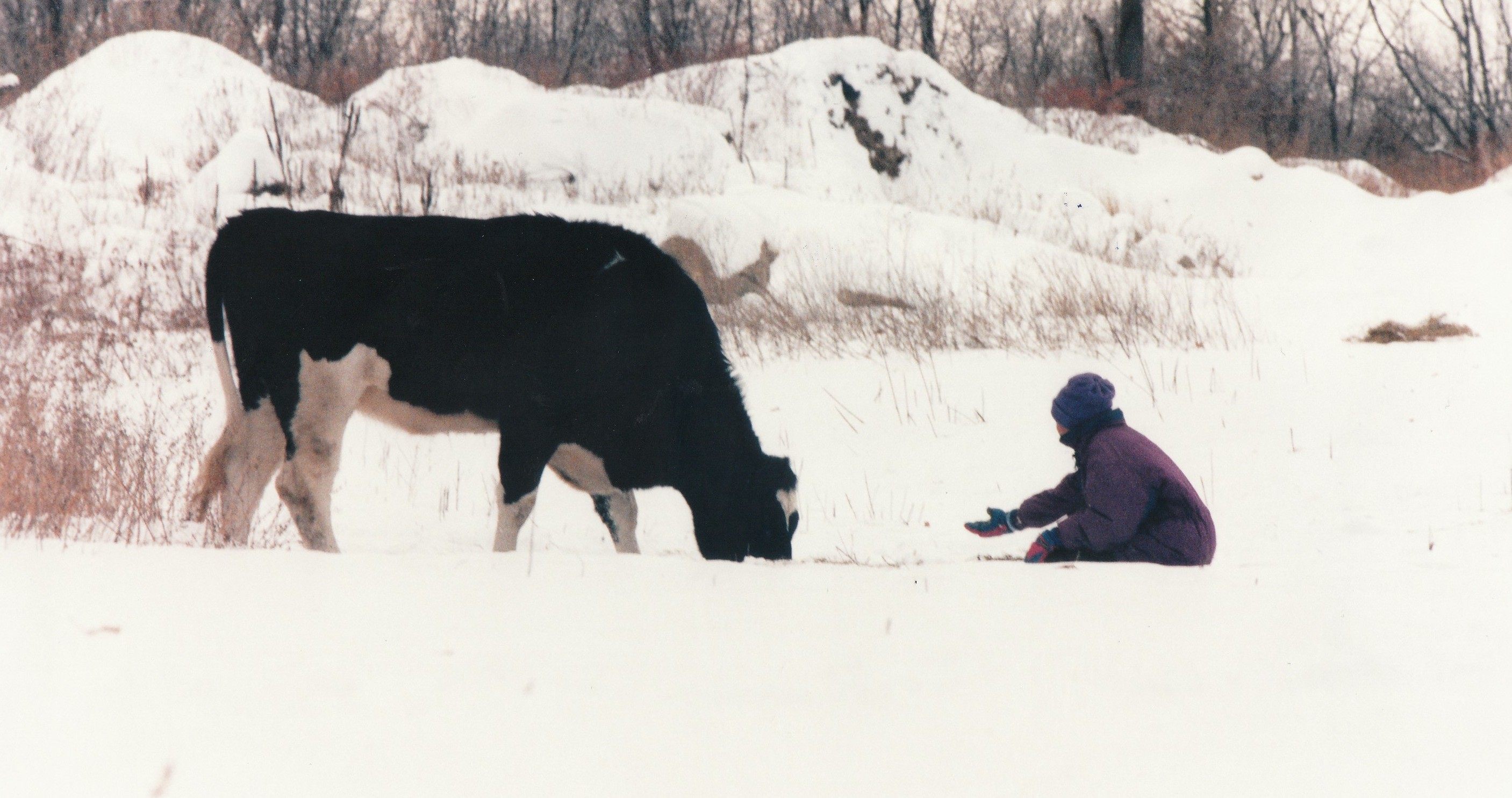 Meg Randa earns Emily’s trust. (Photo: Meg Randa/Middlesex News)
Meg Randa earns Emily’s trust. (Photo: Meg Randa/Middlesex News)
“All of a sudden she was before me,” Meg says. Emily was too huge to handle alone, so Meg coaxed her out to a clearing with handfuls of hay, and then brought in a trailer filled with even more, plus blankets. After a couple of days, the cow allowed herself to be led onto the trailer, and she was brought to the Peace Abbey to live out her days as freely as a domestic animal can.
But Emily wasn’t just free, she was famous. Post-recapture, her legend only grew. She got written up in People and Parade. She was a bridesmaid in two weddings (“she ate the bouquet in one of them,” Meg says). She served as the spokescow for several animal rights organizations—visitors came to see her and left convinced that they would “never eat another hamburger,” Meg says.
Aspects of Emily’s story and presence resonated with several religious and cultural traditions—she escaped on November 14, the birthday of the beloved first prime minister of India, Jawaharlal Nehru, and the white marking on her forehead resembled that country’s silhouette. She was also at large for “40 days and 40 nights”—the amount of time it rained when God cleansed the world in the Bible—and was finally brought in on Christmas Eve. Combine this with the Peace Abbey’s interfaith mission, and you had pilgrims of all sorts flocking to a tiny abbey, in the middle of a tiny town, to see a huge former fugitive cow.
“We’d go out to the barn and Emily would have a red dot on her forehead, and there’d be bananas and flowers and things at her feet,” Meg said. When a coalition of Hindus arrived from India to visit, one, Jayenti Patel, said it was “like meeting a famous person.”
 Emily’s distinctive India-shaped marking. (Photo: Meg Randa/Middlesex News)
Emily’s distinctive India-shaped marking. (Photo: Meg Randa/Middlesex News)
When Emily died, of bovine leukemia, in 2003, the Peace Abbey commissioned a life-sized replica in her honor. It stands in Sherborn to this day, next to a similar statue of Mahatma Gandhi. Some of Emily’s supporters brought bits of her hair and blood to India and released them into the Ganges River, making Emily one of the best-traveled ungulates the world has ever known. It was a fitting end for the cow who dared to take a leap.
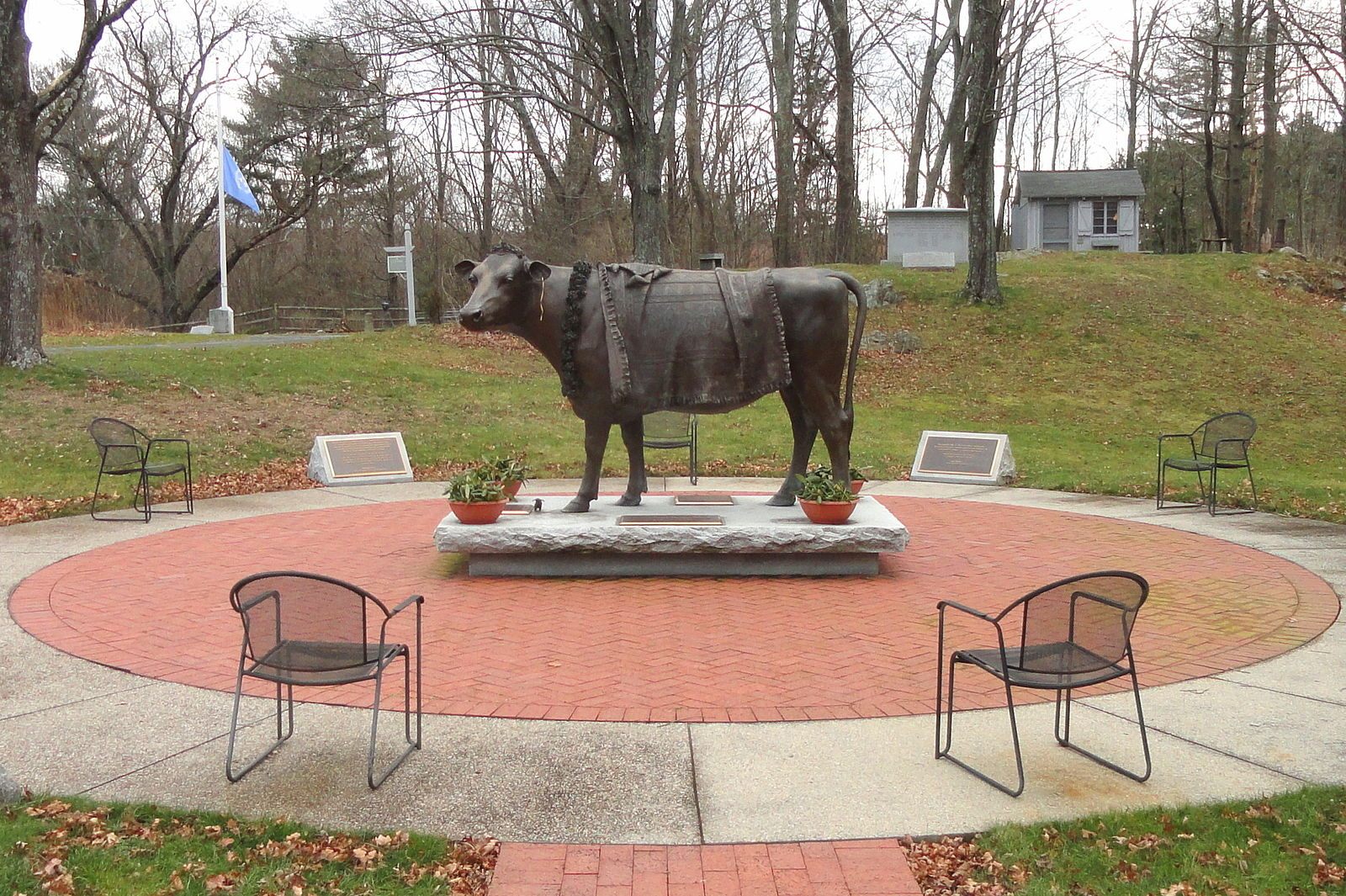 Emily’s statue in Sherborn, Massachusetts. (Photo: Daderot/WikiCommons CC0 1.0)
Emily’s statue in Sherborn, Massachusetts. (Photo: Daderot/WikiCommons CC0 1.0)
Naturecultures is a weekly column that explores the changing relationships between humanity and wilder things. Have something you want covered (or uncovered)? Send tips to cara@atlasobscura.com.
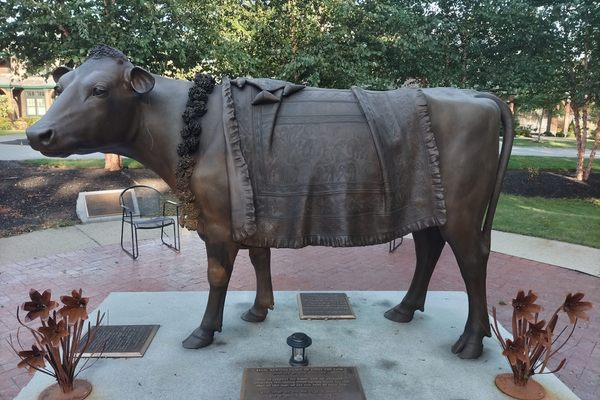















Follow us on Twitter to get the latest on the world's hidden wonders.
Like us on Facebook to get the latest on the world's hidden wonders.
Follow us on Twitter Like us on Facebook